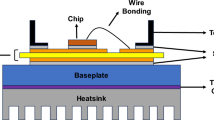Abstract
This study proposes a modeling process for conveniently analyzing the thermal resistance of a double-sided cooling (DSC) power module used in automotive inverters. Conventionally, circular-shaped pin-fins are adopted in the heat sinks used in DSC modules. This study utilizes finite element method (FEM) simulation to estimate the junction-to-fluid thermal resistance and compares the simulation results with measured values. The modeling process achieves high accuracy, approximately 97%. The analysis involves an optimized design of the circular pin-fins, exploring parameters such as pin–fin spacing and diameter size. This optimization results in a sufficiently low device junction temperature while maintaining an acceptable pressure drop. Furthermore, the developed model is applied to two uncommon pin–fin shapes, cone and oval, and their performance is evaluated. The oval-shaped pin-fins reduce the device temperature by approximately 6.7%, from 156.2 to 145.7 ℃, with a slight increase in pressure drop from 2.18 to 2.92 kPa. However, this pressure drop is low enough to supply coolant to a xEV cooling system. These findings enhance the accuracy of thermal resistance analysis for DSC power modules and offer a cost-effective means of estimating results without the need for direct manufacturing and measurement of pin–fin shape changes.














Similar content being viewed by others
References
Poorfakhraei, A., Narimani, M., Emadi, A.: A review of multilevel inverter topologies in electric vehicles: current status and future trends. IEEE Open J. Power Electron. 2, 155–170 (2021)
Hussain, A., Bui, V.-H., Kim, H.-M.: Optimal sizing of battery energy storage system in a fast EV charging station considering power outages. IEEE Trans. Transp. Electr. 6(2), 453–463 (2020)
Zhu, F., et al.: Does the battery swapping energy supply mode have better economic potential for electric heavy-duty trucks? Transportation 15, 100215 (2023)
Ding, X., Du, M., Zhou, T., Guo, H., Zhang, C.: Comprehensive comparison between silicon carbide MOSFETs and silicon IGBTs based traction systems for electric vehicles. Appl. Energy 194, 626–634 (2017)
Yoon, S.W., Glover, M.D., Shiozaki, K.: Nickel-tin transient liquid phase bonding toward high-temperature operational power electronics in electrified vehicles. IEEE Trans. Power Electron. 28(5), 2448–2456 (2013)
Catalano, A.P., Scognamillo, C., d’ Alessandro, V., Castellazzi, A.: Numerical simulation and analytical modeling of the thermal behavior of single- and double-sided cooled power modules. IEEE Trans. Comp. Packag. Manu. Tech. 10(9), 1446–1453 (2020)
Yoon, S.W., Glover, M.D., Mantooth, H.A., Shiozaki, K.: Reliable and repeatable bonding technology for high temperature operational automotive power modules used in electrified vehicles. J. Micromech. Microeng. 23(1), 015017 (2013)
Jeon, J., Seong, J., Lim, J., Kim, M.K., Kim, T., Yoon, S.W.: Finite element and experimental analysis of spacer designs for reducing the thermomechanical stress in double-sided cooling power modules. IEEE Trans. Emerg. Sel. Top. Power Electron. 9(4), 3883–3891 (2021)
Nakatsu, K., Nishihara, A., Sasaki, K., Saito, R.: A novel direct water and double-sided cooled power module and a compact inverter for electrified vehicles. In: European Conference on Power Electronics and Applications (EPE), Lille, France, 1–6, (2013)
Buttay C., et al.: Compact inverter designed for high-temperature operation. In: IEEE Power Elec. Specialists Conference, Orlando, 2241–2247 (2007)
Hosseinirad, E., Aliabadi, M.K., Hormozi, F.: Effects of splitter shape on thermal-hydraulic characteristics of plate-pin-fin heat sink (PPFHS). Int. J. Heat Mass Transf. 143, 118586 (2019)
Sakanova, A., Tseng, T.J.: Comparison of pin-fin and finned shape heat sink for power electronics in future aircraft. Appl. Therm. Eng. 136, 364–374 (2018)
Klaus, P., Andreas, G., Markus, F., Guenter, T.: I. Double-sided cooling technology for emobility. In: (ESSDERC) 49th European Solid-State Device Research Conference, Cracow, pp. 28–30
Acknowledgements
This work was supported by the National Research Foundation of Korea(NRF) grant funded by the Korea government(MSIT) (No. 2023R1A2C2006661 and No. RS-2023-00207865).
Author information
Authors and Affiliations
Corresponding author
Ethics declarations
Conflict of interest
On behalf of all authors, the corresponding author states that there is no conflict of interest.
Rights and permissions
Springer Nature or its licensor (e.g. a society or other partner) holds exclusive rights to this article under a publishing agreement with the author(s) or other rightsholder(s); author self-archiving of the accepted manuscript version of this article is solely governed by the terms of such publishing agreement and applicable law.
About this article
Cite this article
Cho, S., Yoon, S.W. Analysis model for thermal resistance of double-sided cooling power module with pin–fin heat sink used in xEVs. J. Power Electron. 23, 1880–1887 (2023). https://doi.org/10.1007/s43236-023-00708-x
Received:
Revised:
Accepted:
Published:
Issue Date:
DOI: https://doi.org/10.1007/s43236-023-00708-x




